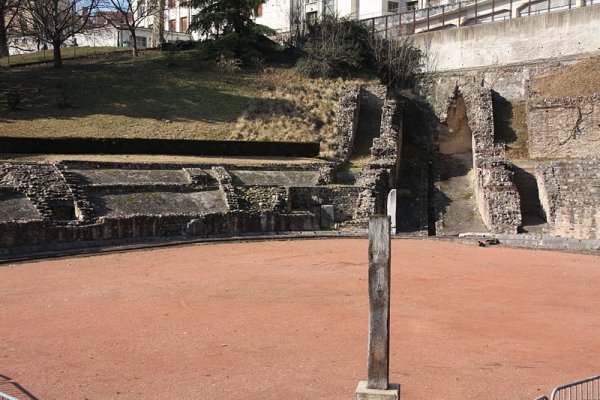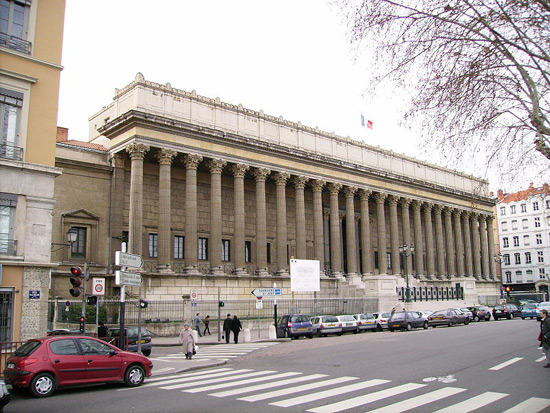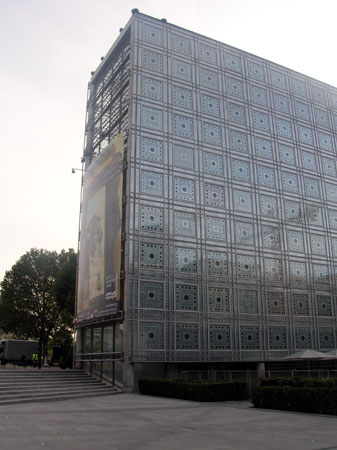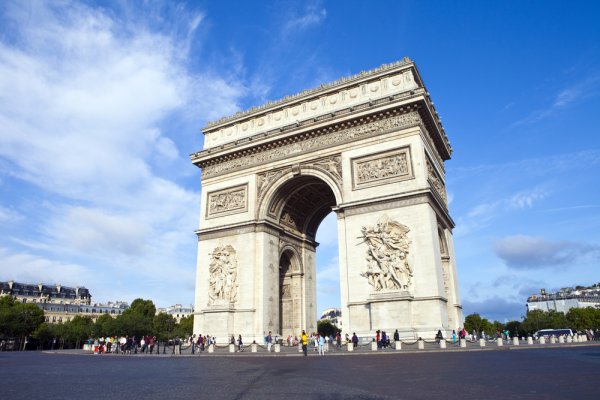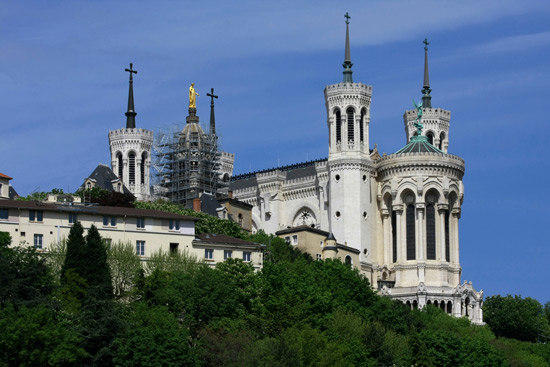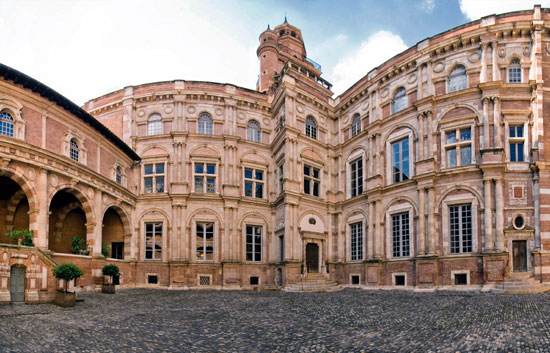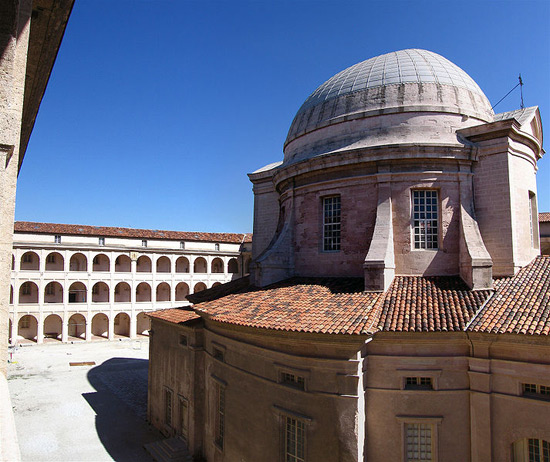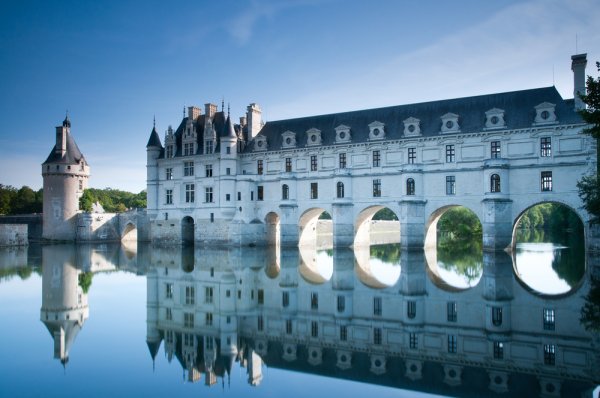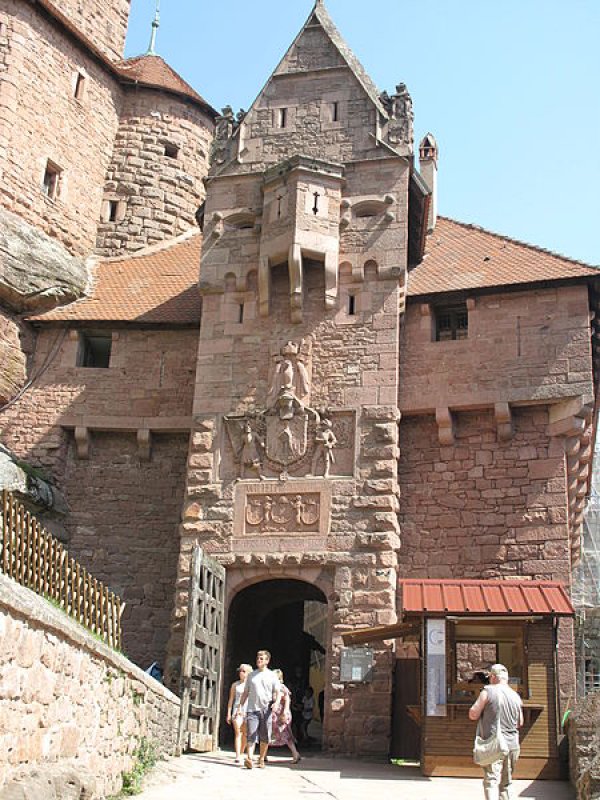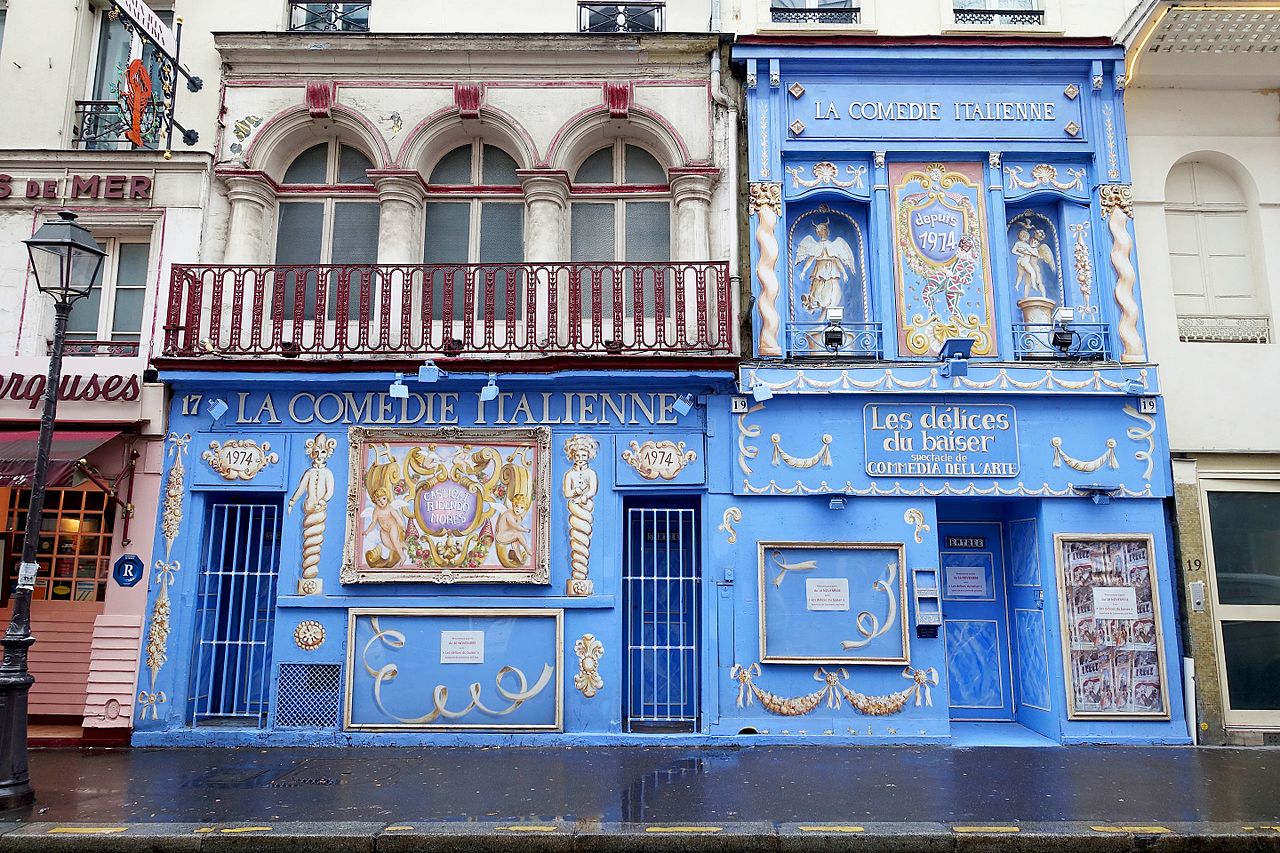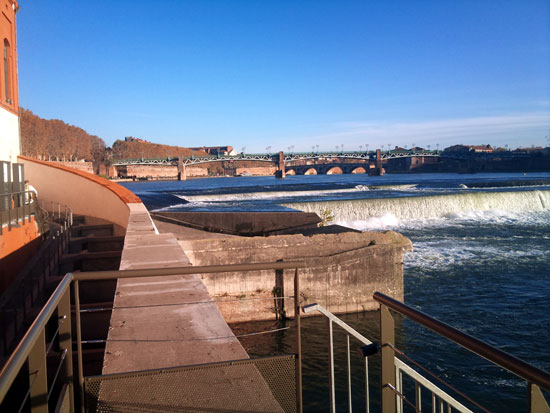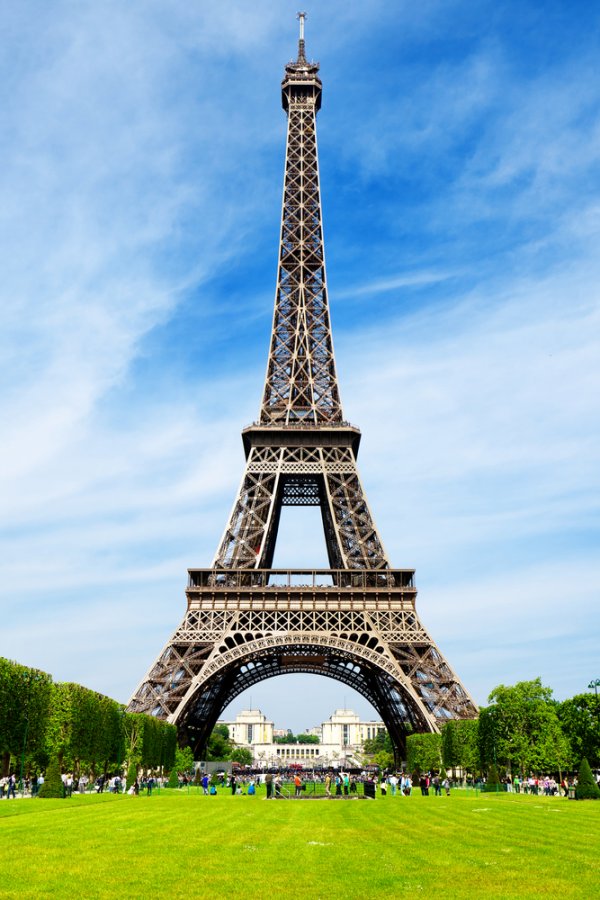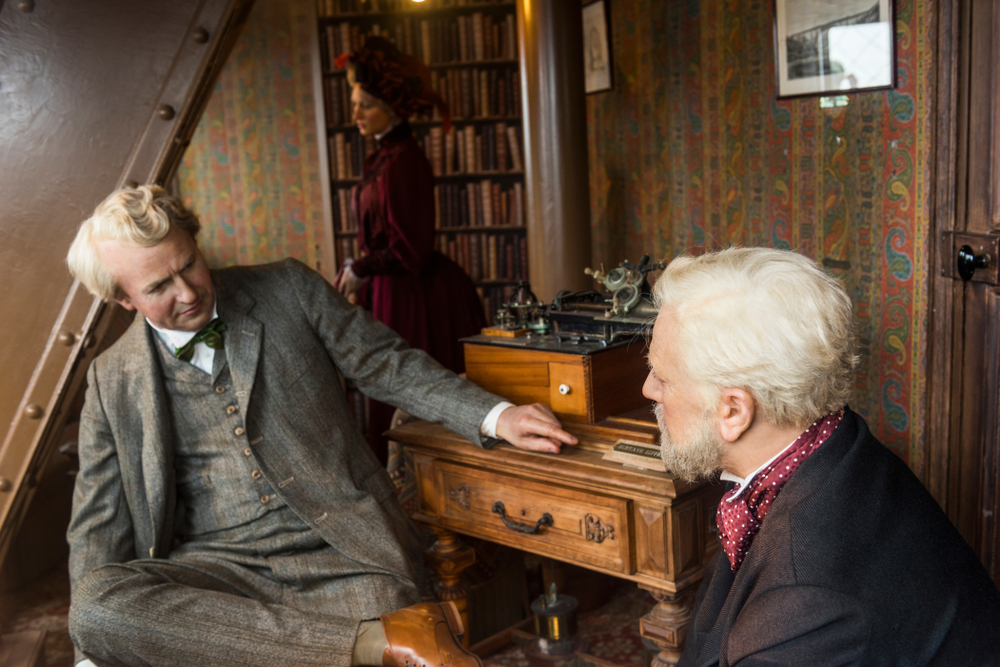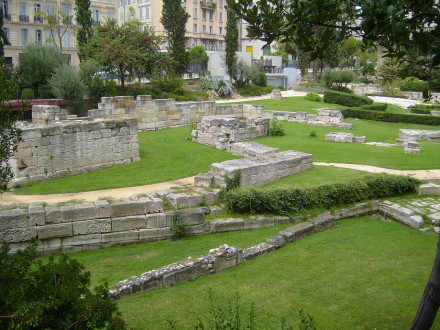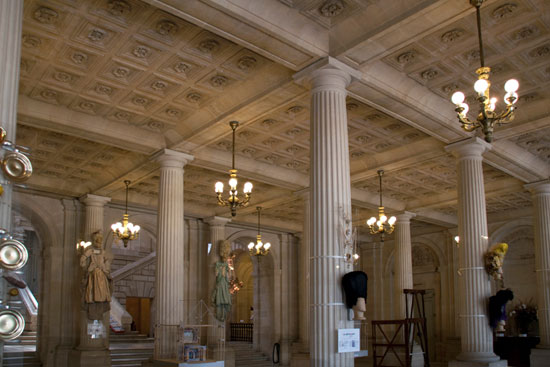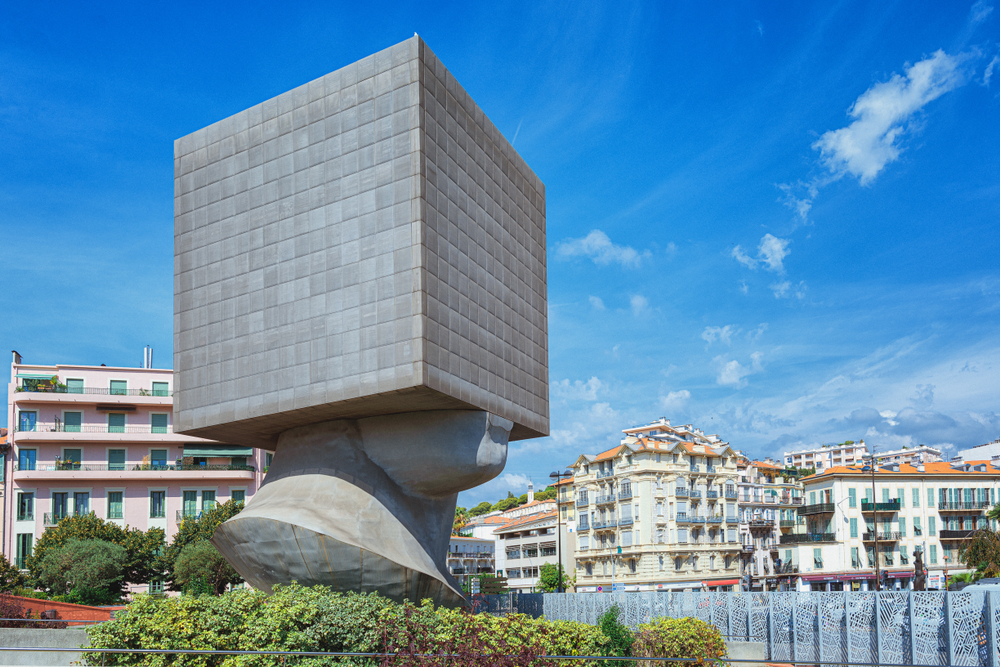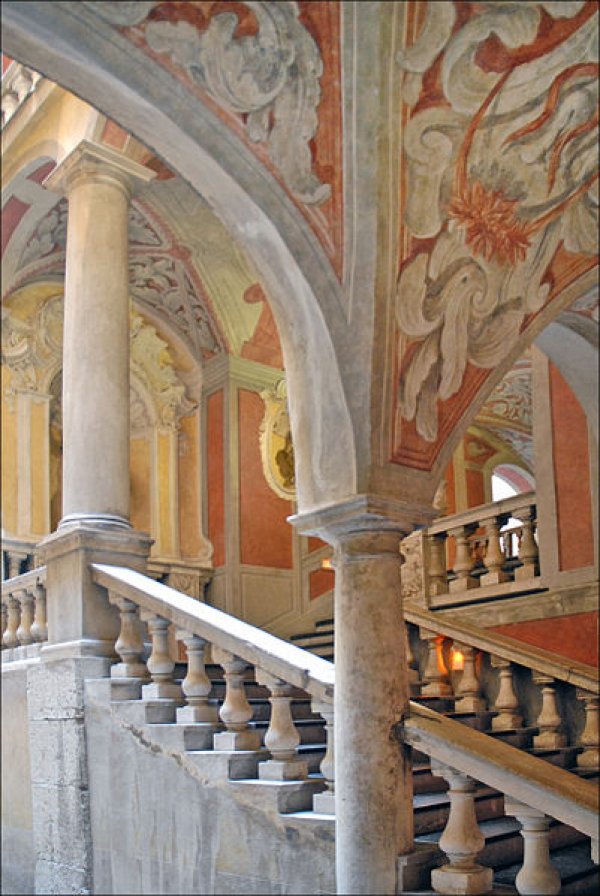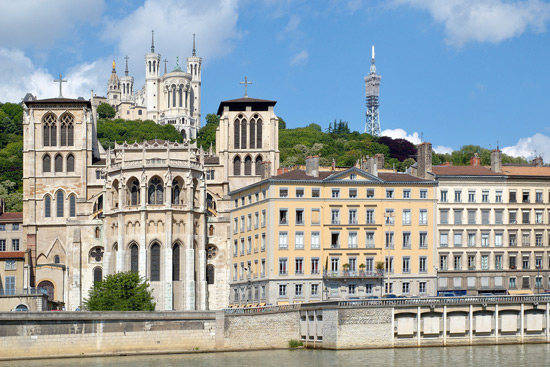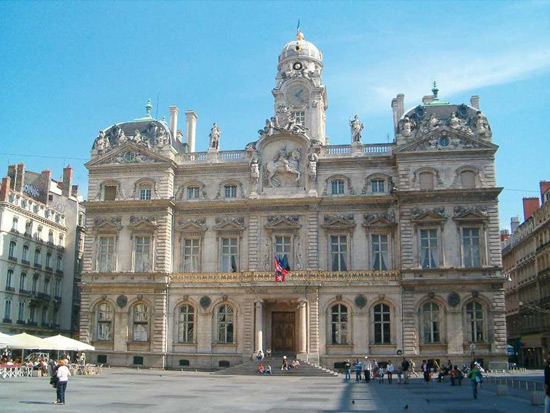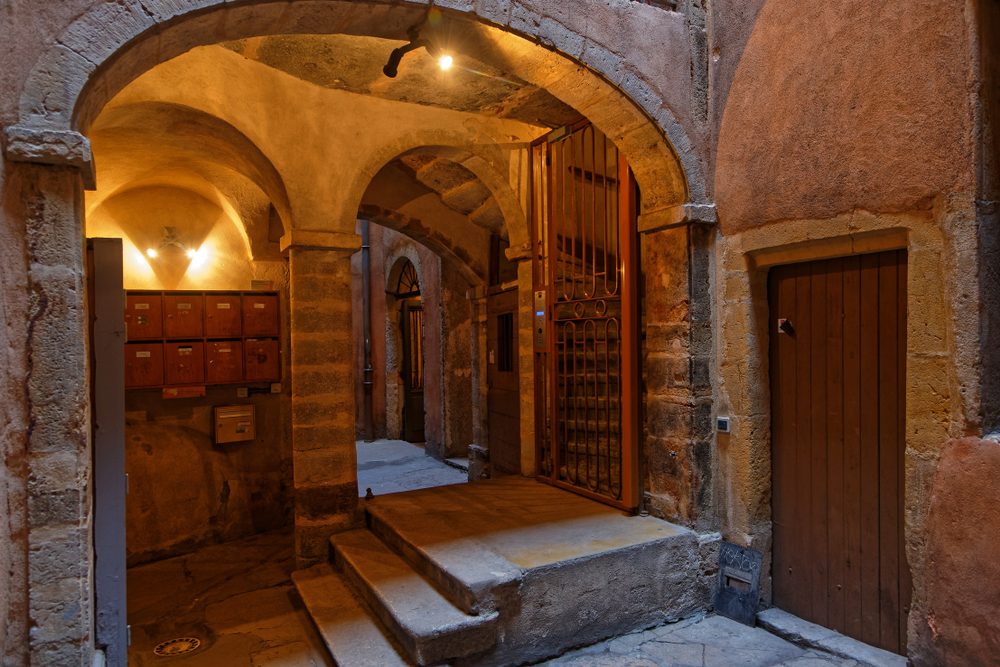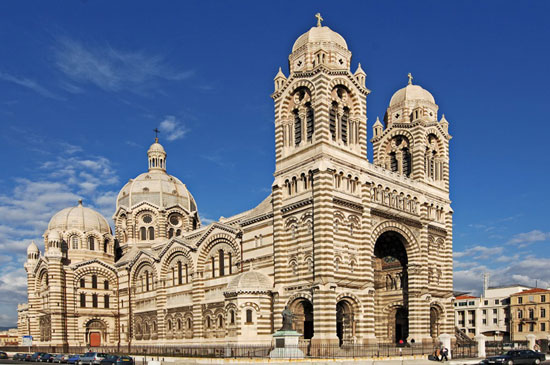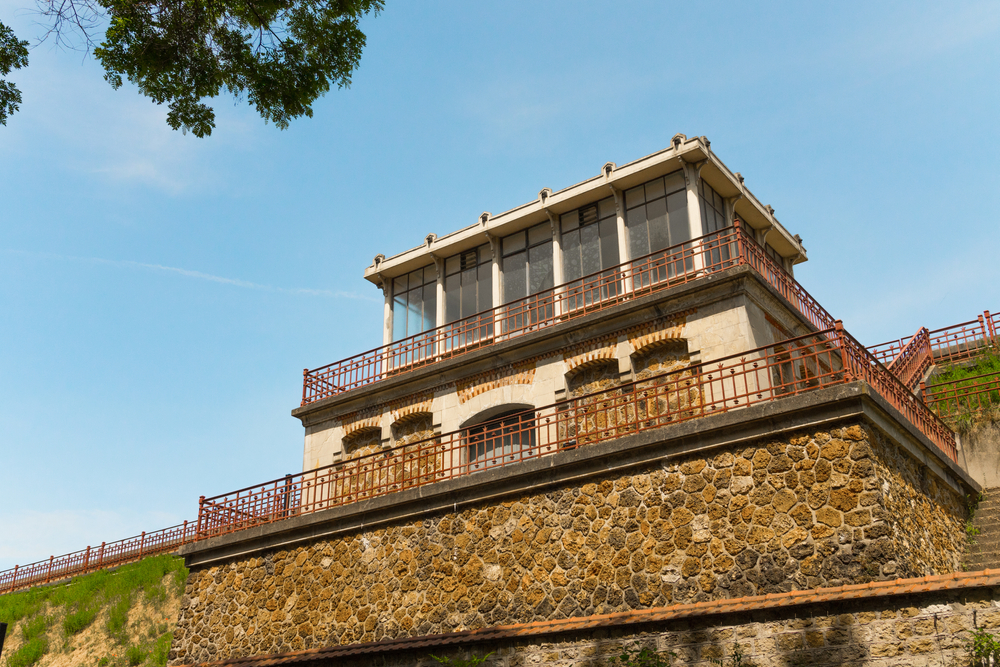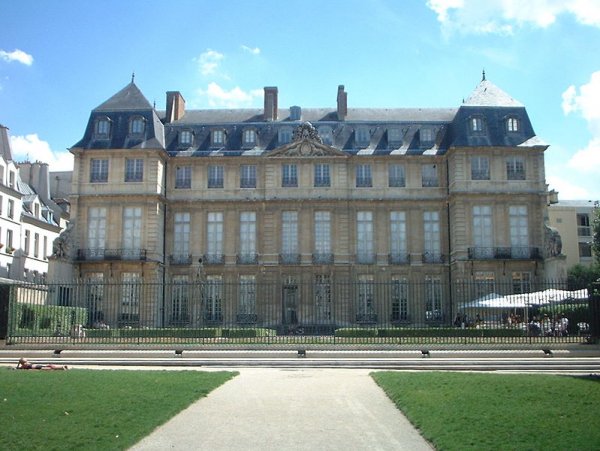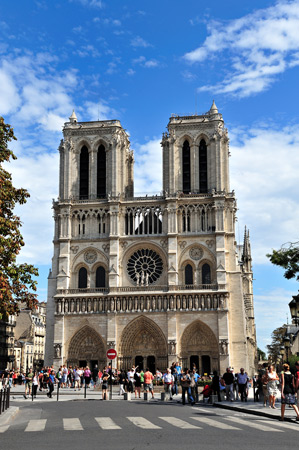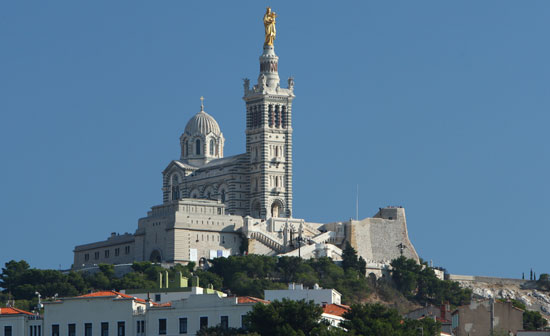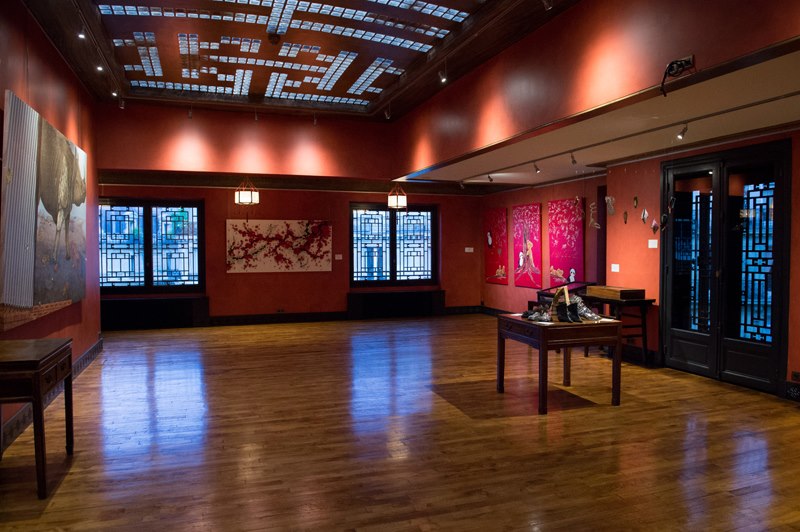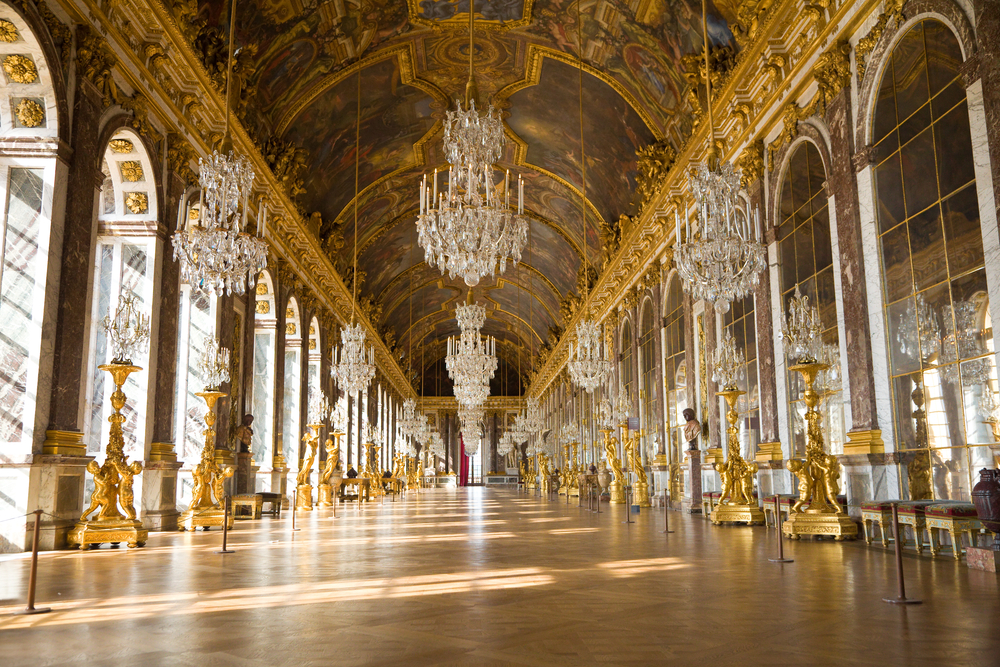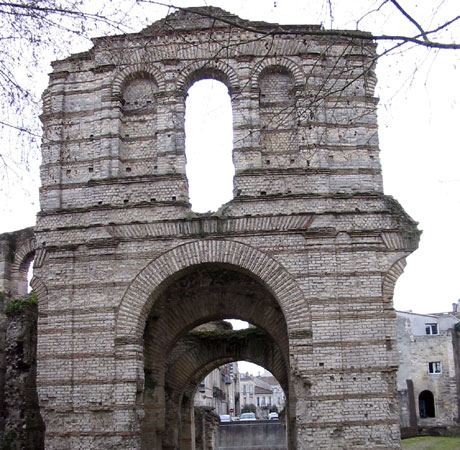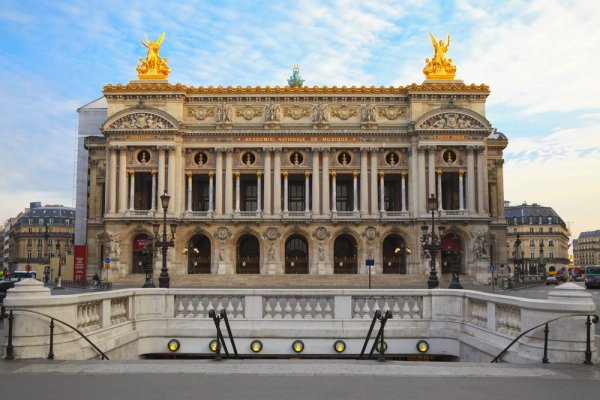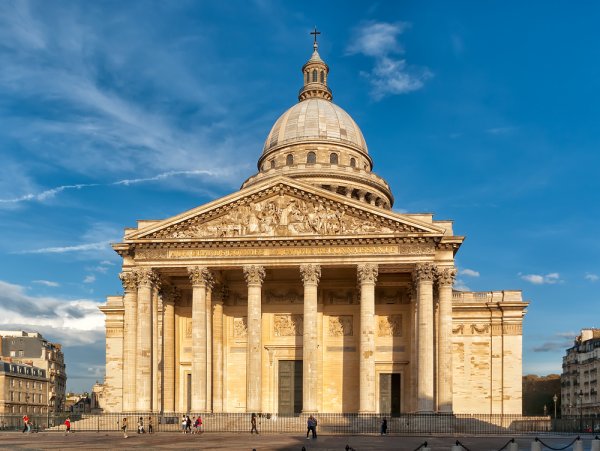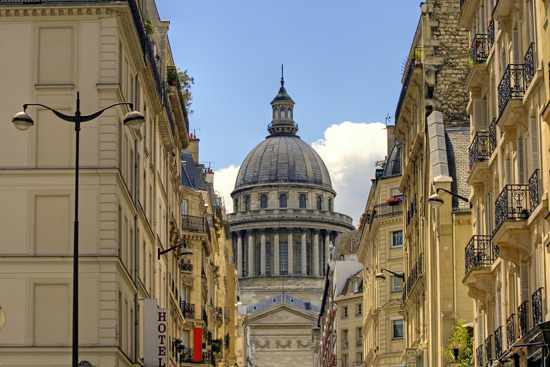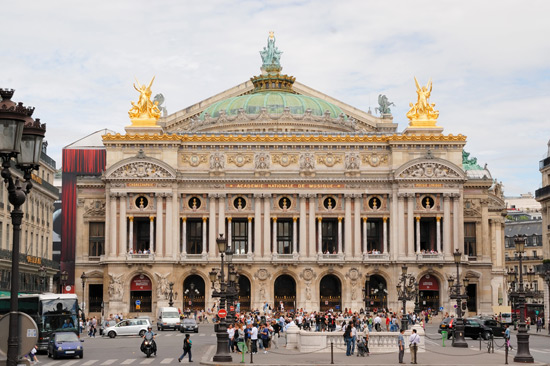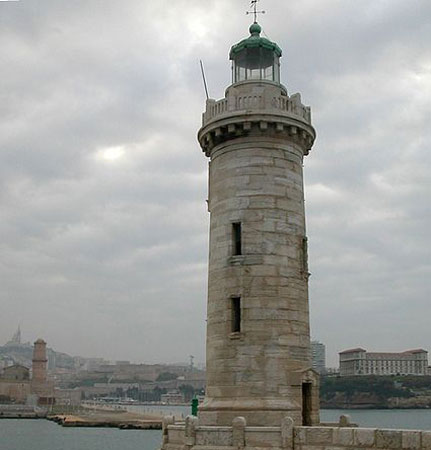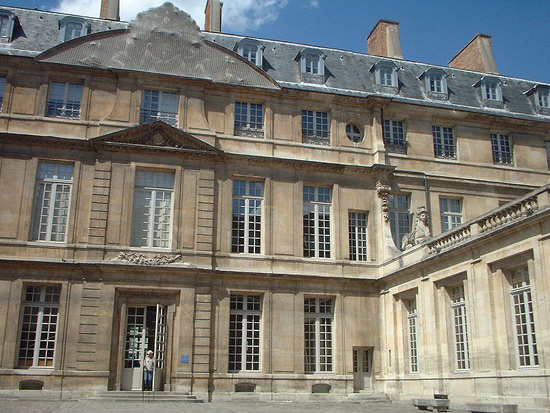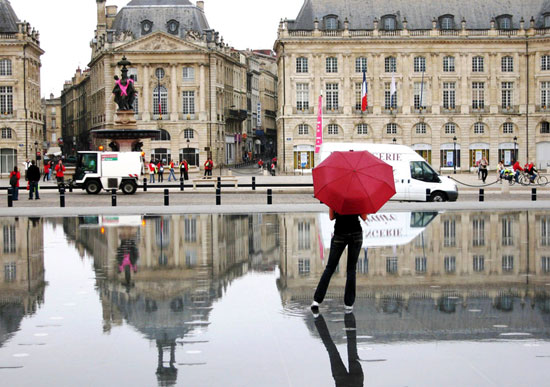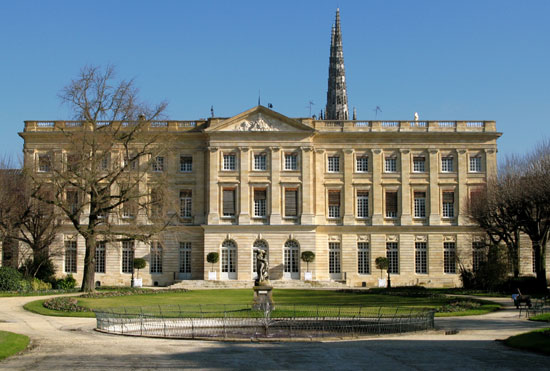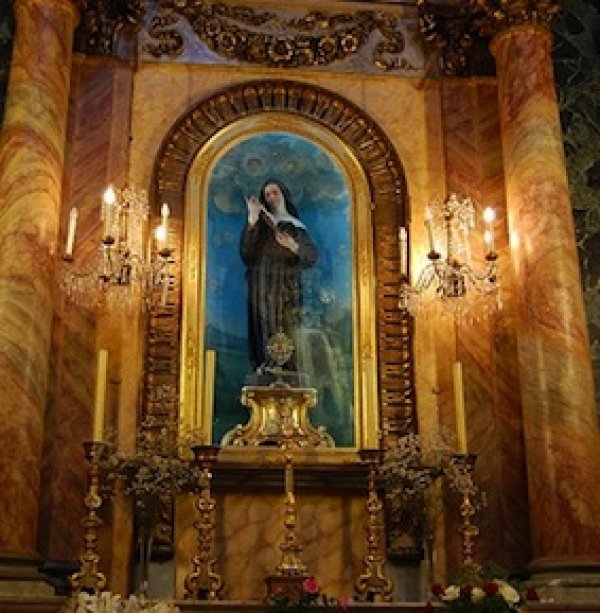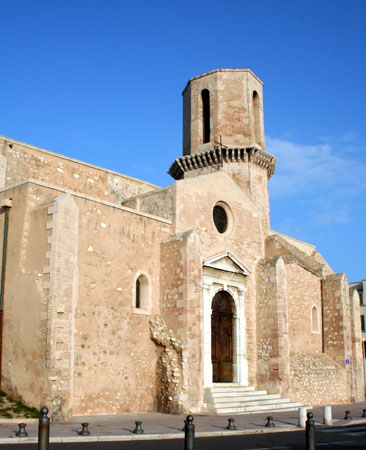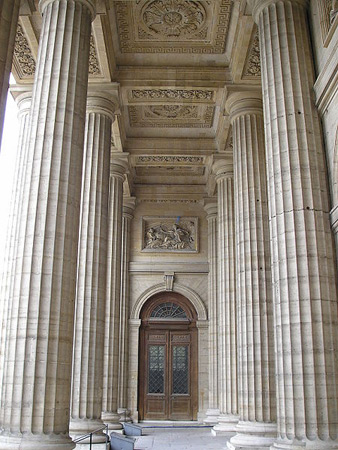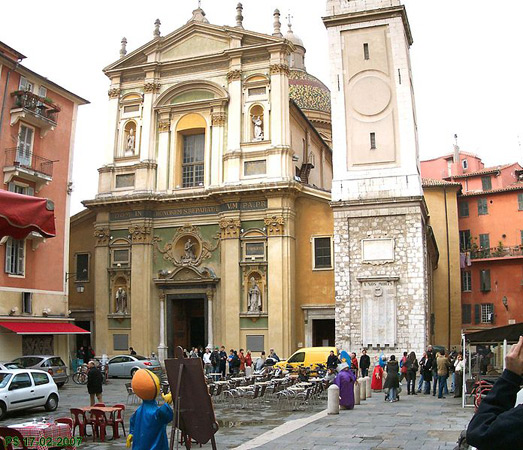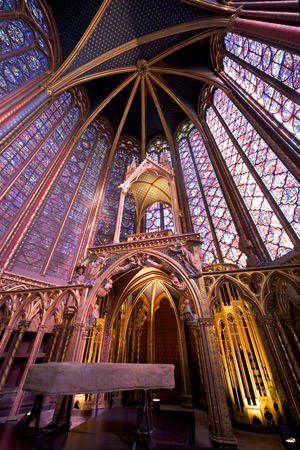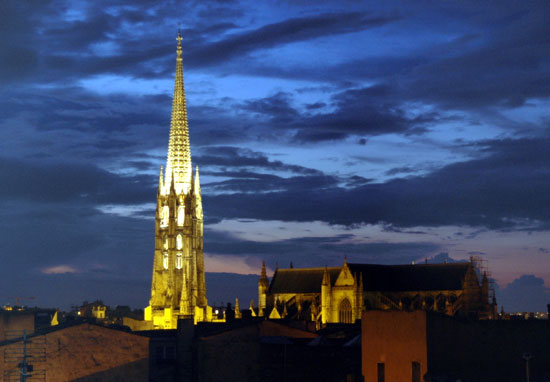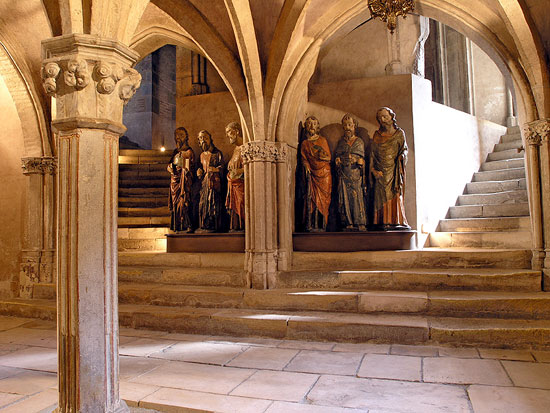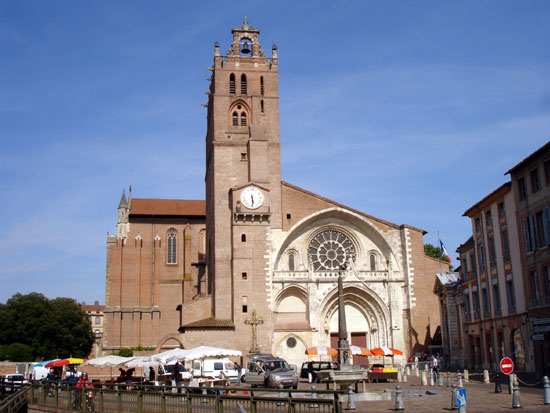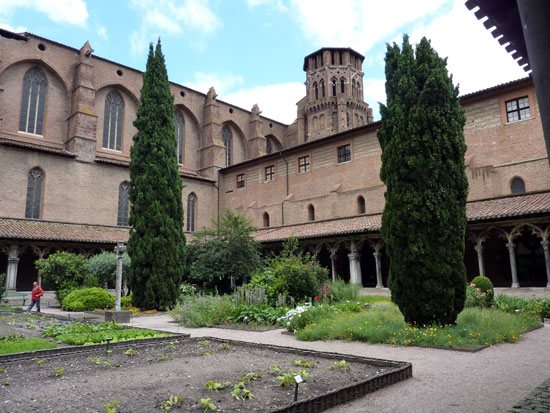Points of Interest
Amphitheater of the Three Gauls
Amphitheatre des Trois Gaules Off Rue Burdeau and Rue Sportisse
Lyon, France
This stunning relic from around 19 CE fits the classic template familiar to anyone who has seen movies such as Gladiator and Ben-Hur. It was here that the 60 tribes of Gaul gathered to celebrate the cult of Rome and its Emperor Augustus. Later on, the first Christians were killed here, but it is claimed that the lions refused to kill the very first martyr, Blandine, so the Romans had to do it themselves. Although considerably ruined, there is enough of the original seating in the south half of the amphitheater to still make it a unique draw. As you tour it you can almost imagine the chariots riding past and the gladiators fighting to the death.
Ancient Palace of Justice
Ancien Palais de Justice Quai Romain-Rolland
Lyon, France
In the heart of the old city, amid the cobblestoned medieval and Renaissance streets, stands the neoclassical Ancient Palace of Justice, designed by renowned architect LP Baltard in 1845. It is an iconic symbol of Lyon: the city's eventful past is recorded on a series of marvelous frescoes located in a cupola-covered room inside the building. It was here that the Italian anarchist Sante Geronimo Caserio was tried for murdering the president of France, Carnot. Notorious Nazi Klaus Barbie was sentenced here almost half a century after he committed his crimes against the French people. On a happier note, the view of the River Saone from here is rather spectacular.
Arab World Institute
Institut du Monde Arabe 1 Rue des Fossés St.-Bernard
Paris, France
Jean Nouvel, the darling of French architecture, made a smash with this innovative cultural institute, completed in 1987. What looks like a regular geometric rectangle clad in metal panels turns out to be a sophisticated modernist façade echoing Moorish screen architecture. There are 1,600 panels, each containing 21 apertures that can be closed and opened electronically to regulate the amount of light penetrating the building. The institute was founded in 1980 to increase cultural cooperation between France and the Islamic world. Inside the building is a display of Islamic artwork such as ceramics, textiles, and glassware dating back as far as the ninth century. There's a substantial library, spaces for temporary exhibitions and performances, as well as a peaceful rooftop café. With access to the ninth floor roof terrace, Le Ziryab has some of the best River Seine views in Paris.
Arc de Triomphe
place Charles-de-Gaulle
Paris 75008, France
Arc de Triomphe is one of the most famous monuments in France and the world's second-largest triumphal arch. Designed by Jean François Thérèse Chalgrin and completed in 1836, the Arc de Triomphe was conceived by Napoleon and dedicated to the glory of his imperial armies. The monument has a height of 51 meters (167 feet) and a width of 45 meters (148 ft). There are many sculptures and inscriptions on the Arc's façade and it stands over the Tomb of the Unknown Soldier. Inspired by the Roman Arch of Titus, the structure is so huge that a stuntman once piloted his plane through it.
Arènes de Lutèce
49 Rue de Monge
Paris, France
Built during 1st century CE after the Roman conquest of Lutetia, as Paris was then known, Arènes de Lutèce is the earliest vestige of the city’s history. These days it is a place where people come to relax, but in Roman times it served as a theater and arena holding up to 12,000 people. This architectural gem was nearly demolished in the 19th century but was fortunately saved because of a successful petition spearheaded by French writer Victor Hugo.
—Information provided by Paris Convention and Visitors Bureau
Basilica Notre-Dame de Fourvière
8 Place de Fourvière
Lyon, France
Basilica Notre-Dame de Fourvière is arguably the holiest site in a city. It was built in 1870 to endorse the power of the Roman Catholic Church as a rebuff to the secularization of France's Third Republic. Wherever you are in the city you can see the glowing angelic whiteness of its grand turrets and crenellated walls. The giant golden statue of the Virgin Mary is its most unique aspect, quite unlike anything else you'll see on your travels. Powerful lights shine on it during annual festivities held each October 8, bringing out its full radiance. If you can make it up the 287 steps to the Basilica's observatory then you'll be rewarded with a glorious panoramic view of Lyon.
Basilica of the Sacred Heart
Basilique du Sacré-Cœur 35 rue du Chevalier-de-la-barre
Paris 75018, France
The Basilique du Sacré-Cœur (Basilica of the Sacred Heart) is a Roman Catholic church designed by Paul Abadie in a Romanesque-Byzantine architectural style. The church was built after France’s defeat in the 1870 Franco-Prussian war. Although the foundation stone was laid in 1875, construction work on the church was completed only in 1914. It opened as a place of worship after the First World War. The church is made of a stone that oozes calcite during damp weather, which ensures that the church's white color never changes even in bad weather or heavy pollution. It is a famous landmark located at the summit of Montmartre butte, the highest point in Paris.
Bemberg Foundation
Fondation Bemberg Hôtel d'Assézat Place d'Assézat
Toulouse, France
For a rich combination of art and architecture, visit the Hôtel d'Assézat off rue de Metz. And rich is most definitely the appropriate word. Both the townhouse and the art collection it houses are products of two of the wealthier men associated with Toulouse. The first, Pierre d'Assézat, commissioned the city's top 16th-century architect, Nicolas Bachelier, to build an hôtel particulier which would show off his success in the woad trade. The second, Georges Bemberg, was an Argentine industrialist with Franco-German roots and a profound love of art. He spent his life and fortune collecting the works of Pierre Bonnard (the foundation is reputedly the world's largest collection of Bonnard), along with works by Monet and Matisse, dozens of Venetian paintings, and a hoard of Chinese porcelain. The building was restored by the city especially to house this excellent collection, which opened in 1995.
Bourse Palace
Palais de la Bourse 9 La Canebière
Marseille 13001, France
The Palais de la Bourse, located along Marseille's most famous boulevard, is younger than the institution it houses. France's first chamber of commerce was established in Marseille in 1599. Charged with defending the interests of commerce and the port, the chamber originally met in the town hall. When its importance outgrew this space in the 1800s, the Palais de la Bourse was constructed, its architectural goal being to achieve an extraordinary palace while allowing the traders to maintain their traditional outdoor business habits. In addition to the main historic Chamber areas, the building also is home to a small museum showcasing the commercial and maritime history of the city.
Charitable House
La Vieille Charité 2 Rue de la Charité
Marseille 13002, France
Located in the Panier neighborhood, La Vieille Charité is an imposing baroque chapel embraced within a cloister-style courtyard. Built and designed by Marseillais architect Pierre Puget, the chapel was originally constructed as a free respite for the city's poor. It has also been used as a barracks, a soldiers' shelter, and affordable housing for those displaced by World War II. However, today the pink-hued triple-arcaded courtyard and chapel are home to bookshops, a café, and the marvelous Musée d'Archéologie Méditerranéenne (Museum of Mediterranean Archaeology) and Musée d'Arts Africains, Océaniens & Amérindiens (African, Oceanic, and American Indian Art Museum). This art museum contains extraordinary artifacts, including masks from all over the world.
Château de Chenonceau
On the Cher River Chenonceaux
Centre 37150, France
The Château de Chenonceau, located on the banks of the Cher River in the small village of Chenonceaux, is a classic symbol of French history and culture. It was designed by the French Renaissance architect Philibert Delorme. The waters of the Cher River reflect the castle's magnificent architecture and enhance its beauty. The castle contains a vast collection of 16th and 17th-century tapestries, renaissance furniture, and art masterpieces from eminent artists like Le Primatice, Rubens, Le Tintoret, Rigaud, Nattier, and Van Loo. Women have had a large part to play in the castle's history, from its rebuilding overseen by Katherine Briçonnet in 1513 to its protection from destruction during the French Revolution by Louise Dupin.
Château du Haut-Kœnigsbourg
Off of rue du Château Northeast of Dijon Orschwiller
Alsace 67600, France
Situated on the Alsace Wine Route, the Château du Haut-Kœnigsbourg dates back about 900 years and is the biggest castle in Alsace, with enormous walls and towers made of red sandstone. The castle was destroyed and rebuilt twice, most recently in 1899 by Emperor Wilhelm II. Since the castle overlooks the Alsatian plain, many rulers have vied for it, from the time of the Middle Ages until the Thirty Years' War, after which its ruins remained abandoned. In 1993, the French Ministry of Culture declared the castle a national historic site, and it is now one of the most popular tourist attractions in the region.
City Hall of Marseille
Port Marseille, France
In the 1600s, architect Pierre Puget built Marseille's city hall under the strict orders of Louis XIV himself. The Genoese-Baroque structure, located precisely where the old town hall once stood on the right bank of the Vieux Port, stands out among the other buildings in this area as a beautiful example of the civil architecture of the period. Since Marseille's town council has been meeting at this place since the Middle Ages, the spot and the Hôtel de ville represent power and democracy in the city. Today, the building is home to the mayor's offices, the municipal councilors' offices, and other administrative headquarters.
Comédie Italienne
17 Rue de la Gaité
Paris, France
A little theatre devoted to Italian-language plays, Comédie Italienne opened in 1980. It is housed in a former police station, and the Baroque façade of the building gives the theater an appealingly vintage charm. Previously painted red, then in the traditional colors of the harlequin, and finally in the flashy blue it currently sports, the façade features some intriguing details such as little statues of cherubs and the Latin inscription Cadtigat ridendo mores, meaning “One corrects customs by laughing at them.”
—Information provided by Paris Convention and Visitors Bureau
EDF Bazacle Centre
Éspace EDF Bazacle 11 quai St-Pierre
Toulouse, France
Deriving from the Latin word for ford, this hydroelectric power station is located at a shallow neck of the Garonne where Toulousaines have crossed the river for hundreds of years. In the 12th century, mill owners began to harness the Garonne's hydro power, building a rudimentary dam and utilizing the flow of water to drive floating mills. Over the years, the mills grew bigger, land-based, and more profitable (the enterprise was one of Europe's first joint stock companies). In 1890, the Bazacle hydroelectric plant was constructed, and although more modern machinery has been installed since, visitors on guided tours can still see the 19th-century technology. In addition to providing the electricity for more than 3,000 homes, this riverside installation offers space for temporary exhibitions and displays on marine species, including those that use the fish ladder to swim upstream annually.
Eiffel Tower
Tour Eiffel Champ de Mars, 5 Avenue Anatole
Paris 75007, France
One of the most famous structures in the world, the Eiffel Tower is an iron tower that stands 324 meters (1,063 feet) tall, has 1,665 steps, and weighs 7,300 tons. The tower, named after its builder, Alexandre Gustave Eiffel, was constructed for the Paris exposition of 1889 and opened by England's Prince of Wales. Upon completion, the Eiffel Tower replaced the Washington Monument as the tallest structure in the world. Visitors to the tower can reach the summit but require the use of elevators beyond the second floor. In windy conditions, the tower sways between 6 to 7 centimeters.
Eiffel’s Secret Apartment
Champ de Mars
5 Anatole France Avenue
Paris, France
Many people don’t know that the world-famous Eiffel Tower includes a small apartment built into the structure. Located near the top, the apartment was built by the landmark’s designer himself, French civil engineer Gustave Eiffel. The small apartment, at a height of 304 meters (1,000 feet), is referred to as an office by the tower’s website, perhaps a more appropriate term to convey the little gathering space that was off limits to everyone except Eiffel and a few of his chosen guests. One of these was inventor Thomas Edison, who presented Eiffel with a phonograph, a revolutionary invention that both recorded and played back sound. Those who purchase a ticket to the top of the tower can view the apartment—and phonograph—through a window and ponder the 1889 meeting between the two icons, represented by wax figures within. They are seated on chintz-covered chairs in a wallpapered room, complete with wooden furnishings (most are original items) and a grand piano. The setting makes it easy to forget that the apartment is nestled within the clouds, that is, until you see that massive iron beam running through the space and you remember where you are.
Garden of Vestiges
Le Jardin des Vestiges 17 Cours Belsunce
Marseille, France
Long before the modern city of Marseilles rose up around it, an ancient Greek port existed, the remnants of which are within Le Jardin des Vestiges (Garden of Vestiges). The preserved archeological site includes parts of an old Roman road as well as portions of quays and wharves that once saw busy shipping activity about 2,500 years ago. Wander the landscaped garden, noting the contrast between the worn rock portions and the modern buildings surrounding the area, which is near the Vieux Port. The ruins are part of the city’s Museum of Marseille, and admission to the outdoor site is included with the museum’s ticket price.
Grand-Théâtre
Place de la Comédie
Bordeaux, France
Completed in 1780, this harmonious neoclassical theater looks more like a state building than a performance venue. This might explain why the Grand-Théâtre served briefly as the home of the National Assembly in 1871, when France was in the midst of a humiliating military defeat by the Prussians. Designed by French architect Victor Louis, it's a striking and regular structure faced with 12 Corinthian columns, each one surmounted by a female figure (the 12 statues include three Greek goddesses and the nine muses). If you can, buy an upper circle ticket for an opera or ballet performance. The view from the top of the 1,100-seat auditorium might be vertiginous, but it's the best way to see the marvelous interior, including the dome painting by François Roganeau. Noted for its acoustics, this venerable venue has hosted some memorable performers over its 230 years, including Franz Liszt and Placido Domingo. It is home to the Opéra National de Bordeaux.
Hôtel de Bernuy
1 rue Léon Gambetta
Toulouse, France
Although it is now the home of the Lycée Pierre de Fermat, this sumptuous 16th-century townhouse was once the private residence of Toulouse's most successful pastelier. (Pasteliers were traders in the plants known as woad, which produced a vivid blue dye.) Don Juan de Bernuy was a Jewish trader from Burgos who had swapped the threat of the Spanish Inquisition for Toulouse's commercial opportunities. He became incredibly successful, amassing a huge fortune and purchasing several titles and districts around the region. His hôtel particulier (townhouse or mansion) is fittingly grand, with a Gothic exterior that conceals a sensational stone courtyard, almost Venetian in execution, topped by an eight-sided tower. De Bernuy's life was similarly full of overblown stories and deeds. He once paid an exorbitant Spanish ransom to bail out France's imprisoned King François, and was gored to death during a private blood sport bout between dogs and a bull.
La Tête Carrée Library
Esplanade Kennedy
Nice 06000, France
If you think a visit to a French library sounds boring, think again. Because even if you don’t go inside, gazing at the sight which is La Tête Carrée Library is a surreal and thought-provoking experience. The library is also a sculpture, depicting a neck and the lower part of a chin, with the rest an imposing symmetrical block where a head would normally be. Created by French artist, Sacha Sosno, the library/sculpture is called “Thinking Inside the Box.” Perhaps surprisingly, inside the sculpture are three floors of library, Nice’s main branch, which stands 25 meters (85 feet) tall. A evening stroll by the library reveals lights within, a glowing indication that there are indeed people within, thinking inside this box.
Lascaris Palace
Palais Lascaris 15 Rue Droite
Nice, France
Located in Nice's historic center, the baroque Palais Lascaris was the former home of the Lascaris-Vintimille family, who lived there until 1802. In 1946, a comprehensive restoration effort by the city brought back the palace's original grandeur and established it as a historic monument. This lavish, richly decorated, and pleasingly colorful estate features vaulted ceilings adorned with frescoes, grand sweeping staircases, and finely detailed ornaments. The most elaborate floor is the étage noble, which retains several of its 18th-century panels and plaster adornments. Throughout the home, visitors can discover Flemish tapestries, 12th-century furnishings, and other treasures. The main living quarters share the palace grounds with a restored pharmacy, built in 1738, which retains its original delftware accessories. The Palais Lascaris is open Wednesday to Monday from 10am to 6pm and admission is free.
Lavirotte Building
29 Avenue Rapp
Paris, France
Paris' Lavirotte Building is an eye-catching, asymmetrical six-story structure in the tranquil neighborhood surrounding the Eiffel Tower. Built between 1899 and 1901 by architect Jules Lavirotte, the building features a design reminiscent of Antoni Gaudí’s work in Spain. It is one of the best-known surviving examples of Art Nouveau architecture in Paris. Curved lines, dissimilar windows, unusual colors and, above all, beautiful mosaic cladding and an intricately sculpted door (featuring a naughty detail) make this a true masterpiece that one never tires of gazing at.
—Information provided by Paris Convention and Visitors Bureau
Lyon Cathedral
Cathedrale Saint-Jean-Baptiste de Lyon 70 Rue Saint-Jean
Lyon, France
Lyon Cathedral (officially, Cathedrale Saint-Jean-Baptiste de Lyon) was built over several centuries on the site of two major churches of the early Middle Ages, whose remains can be viewed today in the archeological garden next door. The cathedral's greatest moment came in 1600 when it hosted the lavish Renaissance wedding of King Henry VI and Maria de Medici. The 12th-century apse of the building is regarded as the pièce de résistance of Lyonnais architecture, while the window tracery and vaulting of the side chapels is strikingly intricate. The cathedral's distinctive feature has to be the astronomical clock that stands 30 meters (90 feet) high and chimes four times a day.
Lyon City Hall
1 Place de la Comédie
Lyon, France
Situated between the grandeur of the Place des Terraux and the Place de la Comedie, Lyon City Hall was built between 1645 and 1651. Its design is noteworthy, especially its pediment, belfry, and grand half-relief of Louis XIV, which stands out from afar. It's no wonder that this building was declared a historic monument by the French state over a hundred years ago. As with other major sights in Lyon, the best way to see the City Hall is by night when it is illuminated by dozens of miniature lights built into its façade.
Lyon’s Secret Passages
Vieux-Lyon and the Place de la Croix-Rousse areas
Lyon, France
Hearing of secret passageways brings with it an air of mystery, though Lyon’s traboules were built for very practical purposes. The name of the passageways derives from the Latin trans-ambulare, which means “to pass through,” and the city’s first traboules date to the 4th century, built to provide convenient access to fresh water. The passageways in the Croix-Rousse district were built as meeting places for Lyon’s silk workers, of which there were thousands. Unfortunately, the majority of the traboules are not open to the public but the ones that are offer an experience that feels like walking back in time.
Look for an identifying seal that denotes the publicly accessible passageways, with Croix-Rousse’s traboules noted by arrows accompanied by a lion's head. Start the journey in this district, the city’s 4th, at the underground station Croix-Rousse. Vieux-Lyon passageways are indicated with a bronze shield, with the tourist office at Place Bellecour in the 2nd district a good starting point. The city’s longest traboule runs between 54 Rue Saint-Jean and 27 Rue du Bœuf. One famously picturesque traboule begins at 9 Place Colbert/14 bis montee Saint Sebastion and features a lengthy and historic external staircase.
Marseille Cathedral
Place de la Major
Marseille, France
The Cathedral of Sainte-Marie-Majeure, also called La Major, has a long and storied history. This religious entity was founded in the 4th century, expanded in the 11th, and completely rebuilt between 1852 and 1893 by architects Léon Vaudoyer and Henri-Jacques Espérandieu. With its cupolas, turrets, and towers, the present day Romano-Byzantine Cathedral—which stands at 60 meters (197 feet) high and 140 meters (459 ft) long—dwarfs the remains of the 11th-century cathedral beside it. Because of public protest at the time the newest structure was built, the 11th-century building managed to keep her altar, choir, and transept intact.
Montsouris Reservoir
Pavillon de la Porte d’Arcueil
113-115 Rue de la Tombe Issoire
Paris, France
The attractive glass pavilion that catches your eye a stone’s throw from the Parc Montsouris is not merely decorative, it’s a public utility building. One of Paris’ largest reserves of drinking water, Montsouris Reservoir was built in the late 19th century to supply Parisians with clean water. Roughly 200,000 cubic meters (7,062,933 cubic feet) of water is stored at an ideal temperature of 12 degrees Celsius (53.6 degrees Fahrenheit) in this two-story underground reservoir. Visitors will be fascinated as they look down at this cathedral of water—1,800 arch-shaped pillars supporting a huge volume of clear water.
—Information provided by Paris Convention and Visitors Bureau
Musée Picasso
5 rue de Thorigny
Paris 75003, France
The Musée Picasso, designed by architect Jean Boullier is considered one of the finest French historic houses in the Marais district of Paris. Prior to its establishment as a museum, the building saw several owners during its lifetime. The museum contains more than 3,000 of Pablo Picasso's works, ranging from drawings and paintings to ceramic art, many of them created after his seventieth birthday. The museum also holds Picasso's private collection of art works by masters like Cézanne, Degas, Rousseau, Seurat, de Chirico, and Matisse. In addition, the museum is home to many Iberian bronze works and a collection of ancient art.
Notre-Dame Cathedral
Ile de la Cité 6, Place du Parvis
Paris, France
The Notre-Dame de Paris, commonly referred to simply as Notre-Dame (Our Lady), is a Gothic cathedral and the seat of the Archbishop of Paris. The magnificently constructed building contains beautiful sculptures and stained glass. It is also one of the first buildings in the world to use flying buttresses, which were added to prevent stress fractures. It stands as a fine example of French Gothic architecture and remains an enduringly popular tourist attraction. Originally, though, the addition of buttresses did not sit well with many, who felt it looked like scaffolding and gave the cathedral an unfinished look.
Our Lady of the Guard Basilica
Basilica Notre-Dame de la Garde Rue Fort du Sanctuaire
Marseille, France
La Garde, at 162 meters (530 feet) tall, is Marseille's highest hill; perched on its height, the golden basilica of Notre-Dame can be seen from virtually any point in the city. This fantastic Romano-Byzantine basilica was built by architect Esperandieu in the mid-1800s. Its dome is adorned with colored marble, intricate mosaics, and breathtaking murals, which were restored to their full splendor in 2006. Upon the bell tower, a gilded 10-meter-tall (33-foot-tall) statue of the Virgin Mary holding an infant Jesus stands on an ornate 12-meter-tall (40-foot-tall) pedestal and overlooks the port. Visitors can look for the bullet holes and shrapnel scars left on the northern exterior during Marseille's brutal Battle of Liberation in 1944. As if the architecture of this remarkable landmark weren't enough, visitors are treated to a stunning 360-degree view of Marseille's vast apricot- and terracotta-colored roofs stretched out below the basilica's terrace.
Pagoda Paris
48 Rue de Courcelles
8th Arrondissement
Paris, France
A building in the Chinese architectural style right in the middle of Paris’ stylish 8th arrondissement may come as a surprise. It was built by Ching Tsai Loo, an idiosyncratic art dealer of Chinese origin, who decided to transform a classic Parisian townhouse into a Chinese pagoda to house a private museum. He entrusted the job to the architect François Bloch in 1925. Nearly a century later, this house with its curved tile roof and red façade is a listed monument, and one of the chief attractions of the area.
—Information provided by Paris Convention and Visitors Bureau
Palace of Versailles
Château de Versailles palace d'Armes Versailles
Île-de-France 78000, France
This royal palace was built in four stages spanning various periods from 1664 to 1710. What started as a royal hunting lodge quickly became one of the largest and most magnificent palaces in Europe. This grand structure represents the system of absolute monarchy and attracts millions of visitors from all over the world every year. The palace consists of a number of lavish, opulent rooms like the State Apartments, the Hall of Mirrors (Galerie de Glaces), chapels, and an opera house (l'Opéra). The palace also has numerous parks and outbuildings.
Palais Gallien
Gallien Palace 113 rue Docteur Albert Barraud
Bordeaux, France
Want to find the center of Burdigala? For Bordeaux's principal site of Roman remains, tour the Gallien Palace, an amphitheater that dates back to the end of the Roman Empire in the latter half of the 3rd century. The years have not been kind to the "palace," which was torched by Frankish invaders not long after it was constructed. Ignored for many years by the city, by the 16th century it had became the stomping ground for prostitutes and criminals. Only after the French Revolution was it earmarked as a historical site, and left undeveloped.
Today, visitors can pick their way among the ancient arcades and walls, which once held as many as 17,000 spectators. It's worth a visit at any time of day; go at sunset, and the arches are often illuminated attractively. The gateway is in surprisingly good shape, featuring several precise arches that have defied thousands of years in their solidity. A square next to the monument is a good place to sit and ponder the games once held in the former amphitheater, or pop into the building located at the entrance that shows a 3D rendering of the structure’s original layout.
Palais Garnier
8 rue Scribe
Paris 75009, France
This grand opera house was designed in the neobaroque style by master architect Charles Garnier. The Palais Garnier, also known as Opéra de Paris, was inaugurated in 1875 and was regarded as an architectural marvel of its time. The elaborately ornate building seats about 2,200 people and can hold up to 450 artists on its huge stage. The interiors are richly decorated in velvet and gold leaf, with figures of cherubs and nymphs and bronze busts of famous composers. The interiors also feature marble friezes and beautiful statues of Greek gods. Select highlights of the interior are the massive central chandelier weighing over six tons and the ceiling painted by Marc Chagall. Both the Paris Opera and the Paris Ballet stage productions at the Palais Garnier, although the Paris Opera now uses Opéra Bastille as its principal venue.
Panthéon
Place du Panthéon
Paris 75005, France
The Panthéon was originally a church dedicated to Sainte-Geneviève. It was built by King Louis XV, who promised to erect a new, beautifully constructed structure on the ruins of the church of Sainte-Geneviève if he recovered from a serious illness he was suffering from. After recovering, he appointed master architect Soufflot for this enormous task. The structure of this building reflects the neoclassical style of architecture, with a façade modeled on the Pantheon in Rome. The top of the structure has a small dome based on Bramante's Tempietto.
Panthéon
Place du Panthéon
Paris, France
The Panthéon was originally a church dedicated to St. Geneviève. It was built by King Louis XV, who promised to erect a new, beautifully constructed structure on the ruins of the church of Sainte-Geneviève if he recovered from a serious illness he was suffering from. After recovering, he appointed master architect Soufflot for this enormous task. The structure of this building reflects the neoclassical style of architecture, with a façade modeled on the Pantheon in Rome. The top of the structure has a small dome based on Bramante's "Tempietto."
Paris Opera
Opéra de Paris Garnier 8 Rue Scribe
Paris, France
A grand opera house was designed in the Neo-baroque style by master architect Charles Garnier, Opéra de Paris Garnier—also known as Palais Garnier—was inaugurated in 1875 and was regarded as an architectural marvel of its time. The elaborately ornate building seats about 2,200 people and can hold up to 450 artists on its huge stage. The interiors are richly decorated in velvet and gold leaf, with figures of cherubs and nymphs and bronze busts of famous composers. The interiors also feature marble friezes and beautiful statues of Greek gods. One of the highlights of the interior is a massive central chandelier that weighs over six tons and the ceiling painted by Marc Chagall. Both the Paris Opera and the Paris Ballet stage some productions at the Palais Garnier, although the Paris Opera now uses the Bastille Opera House as its principal venue.
Paris’ Smallest Street
Between 50/52 Rue Beauregard and 87 rue de Cléry
Paris, France
It may appear as a simple staircase, yet Parisians say “street” when referring to Rue des Degrés. It is the smallest street in Paris—only 5.75 meters (18.86 feet) long and 3.30 meters (10.8 feet) wide. In fact, it merely consists of a staircase with 14 steps! Built in 1634 following the demolition of the wall of Charles V, the street played a role in the French Revolution, as a commemorative plaque reminds us: “It was here that the Baron de Batz and his friends attempted to enable Louis XVI’s escape on the morning of 21 January 1793.” Nowadays it is a brightly painted little street featuring murals.
—Information provided by Paris Convention and Visitors Bureau
Phare de Sainte Marie
Passe de la Joliette
Marseille, France
This lighthouse on the inlet to the Old Port was erected in 1855 to mark Marseille's harbor. Made of local limestone, the lighthouse stands 21.3 meters (70 feet) tall, making it an easy-to-spot landmark from numerous vantage points throughout the city. The original flame beacon was upgraded to electricity in 1922 but is no longer in service. This icon of Marseille was featured in the reality television show The Amazing Race.
Picasso Museum
Musée Picasso Hôtel Salé 5, Rue de Thorigny
Paris, France
Musée Picasso, designed by architect Jean Boullier, is considered one of the finest French historic houses in the Marais district of Paris. Prior to its establishment as a museum, it saw several owners during its lifetime. The museum contains more than 3,000 of Pablo Picasso's works, ranging from drawings and paintings to ceramic art, many of them created after his 70th birthday. The museum also holds Picasso's private collection of art works by masters like Cézanne, Degas, Rousseau, Seurat, de Chirico, and Matisse. In addition, the museum is home to many Iberian bronze works and a collection of ancient art.
Place de la Bourse
Bordeaux, France
Those in search of the ultimate picture-postcard image of Bordeaux, should visit Place de la Bourse where the architecture, statues, and fountains provide a beautiful backdrop for family photos. With its striking half-circle of neoclassical buildings beside the Garonne River, this stock exchange-turned-convention center is the quintessential vision of the Atlantic port at the height of its 18th-century prosperity. The Miroir d’Eau (Water Mirror) or Miroir des Quais (Quay Mirror) in front of the buildings is the world’s largest reflecting pool, covering 3,450 square meters (37,136 square feet) and made of granite slabs covered by a thin layer of water. Let the kids get their feet wet or swing by at night for the memorable sight of reflecting lights.
Rohan Palace
Palais Rohan Place Pey-Berland
Bordeaux, France
Commissioned in 1771 by Archbishop Ferdinand-Maximilien Mériadec de Rohan, this sumptuous residence took 13 years to build, by which time Archbishop Rohan had been appointed to a similar position in Cambrai. Not long after it was completed in 1784, the French Revolution threatened such conspicuous displays of opulence. Following the Revolution, the palace evolved into a hotel, a courthouse, a local government headquarters, an imperial palace, and then a royal château. In 1835, it became the Hôtel de Ville, Bordeaux's city hall. Today, its elegant proportions still dazzle, combining a classic Greek portico with a handsome staircase, and a dining room adorned with trompe-l'oeil figures by Lacour and Berinzago. Look for the paneling, the paintings, and the general air of luxury: the Palais Rohan remains one of the best examples of interior decoration from Bordeaux's 18th-century golden age.
Saint Rita Church
1 Rue de la Poissonnerie
Nice, France
Located on the busy, noisy Rue de la Poissonnerie, the Church of Saint Rita is named after another patron saint of the city. Saint Rita, interestingly enough, is the patron saint of the impossible, and dear to the residents of Nice. Technically speaking, this 17th-century church is dedicated to Saint Jacques (or Saint Giaume, according to the Niçois). However the steady flow of devout locals praise St. Rita inside this gilded baroque gem. While a look at the outside of this church is nothing to write home about, the inside is a baroque marvel worthy of a wander. Saint Rita's is filled with multicolored marble, mosaics, detailed gildings and moldings, and other delights.
Saint-Laurent Church
16 Esplanade de la Tourette
Marseille, France
Built in the 1100s, the Roman-Provincial Church of Saint-Laurent is situated where the first Greek temple devoted to the sun god Apollo once stood. In the 17th century, the adjoining chapel of Sainte-Catherine was added. Both structures withstood the destruction of this district (the fishing region of Saint-Jean) during the German occupation in 1943. Thankfully, this allowed the church to retain its austerely beautiful pink limestone façade and some key architectural features unique to Marseille. Inside this charming chapel, one can find several works of art worthy of a look.
Saint-Sulpice
Rue Saint-Sulpice
Paris, France
One of the most distinctive churches in the world, Saint-Sulpice has an unusually wide colonnaded front, framed by two uneven towers. An exercise in 18th-century classicism by Giovanni Servandoni, the church was completed by several architects. The radiant interior contains several murals by Eugène Delacroix. Among the more famous worshippers at this celebrated church were the Marquis de Sade, who was baptized here, and Victor Hugo, who was married here. One of the largest of Paris's churches, the Left Bank site has historically attracted wealthy and aristocratic parishioners. If you're lucky, you'll get the chance to hear the organ, which was played for more than six decades by composer Charles-Marie Widor. More recently, the church was featured in The Da Vinci Code-its floor contains a brass strip known as a "Meridian Line," which was used for astronomical calculations.
Sainte Réparate Cathedral
3 Place Rossetti
Nice 06300, France
This grand cathedral in the old part of Nice is named after the city's patron saint, Sainte Réparate—the 15-year-old virgin martyred in Caesarea in the fourth century and reputedly delivered to Nice in a boat of flowers pulled by two angels. The calm green and beige façade of this cathedral gives no indication of the treasures it holds inside. The luxurious baroque interior, with its three naves and splendid chancel, is replete with thick marble columns, gold embellishments, massive murals, a grand organ, and furnishings adorned with colored stone mosaics. Interestingly, the bell tower looming above the main church was built a century after architect Jean-André Guibert first began work on this Roman Catholic cathedral in the 17th century.
Sainte-Chapelle
4 Boulevard du Palais
Paris, France
On sunny days, the Sainte-Chapelle on the Île de la Cité is breathtaking. Famous for 600 square meters (6,500 square feet) of stained glass windows, this diminutive, almost delicate example of Gothic architecture was constructed for Louis IX, the French king so devout he was later canonized. Louis wanted a chapel to house his most precious religious relics, including Christ's Crown of Thorns, pieces of the Cross, and drops of Christ's blood. He'd purchased these at biblical expense (the relics cost three times more than the building!) from the cash-starved emperor of Constantinople. The soaring vaulted ceiling, thought to be designed by master mason Pierre de Montreuil, is terrific, but it's the kaleidoscope of colors in the Upper Chapel that makes this church so spectacular. Although many visitors try to see Sainte-Chapelle at sunset, it's a smart move to go early in the morning if you want to avoid the long wait for admission.
St. Michael's Basilica
Basilique St-Michel Place Meynard
Bordeaux, France
French pilgrims have been paying their respects at this venerable church since the 15th century. Built in Flamboyant Gothic style, in part by contributions made by Bordeaux's powerful medieval guilds, it still forms a keystone in the chain of churches leading south toward the Spanish pilgrimage city of Santiago de Compostela. Visitors may want to start with the precipitously tall La Fléche bell tower (fléche means arrow), which at 109 meters (358 feet) is one of the highest in the South of France and which stands separately from the basilica. Within the church are fine woodcarvings, alabaster altarpieces from England, and Flemish paintings dating from the 15th century. Two notable attractions that are no longer on show include the stained-glass windows (shattered by Allied bombing during World War II), and the mummified remains discovered beneath the bell tower in 1791: these were displayed for more than a century, but finally laid to rest in 1979.
St. Nicholas Russian Orthodox Cathedral
Avenue Nicolas II
Nice 06000, France
With its onion-like domes sitting atop dazzling towers of blues and oranges, this cathedral is truly one of the most beautiful Orthodox churches outside of Russia. Just one of many Russian attractions in Nice, the Russian Cathedral remains the most illustrious remnant of the Russian aristocracy's affair with the Côte d'Azur. Czar Nicholas II (who ordered and built the cathedral in 1912) and his well-to-do Romanov buddies were lured to the French Riviera for its temperate weather and high-class cultural clout. Both the interior and exterior of this Belle Époque edifice are richly adorned and decked with icons, frescoes, and intricate woodwork. The cathedral is open to tourists, except when church services are held on Sunday mornings.
St. Saturnin's Basilica
Basilique St-Sernin 13 Place St-Sernin
Toulouse, France
This vast basilica is filled with fascinating items and stories, from the largest to the smallest. For starters, it is the largest Romanesque church in the world. Although construction began originally in the 11th century, most of the basilica has been augmented, even the distinctive octagonal tower, which displays both Gothic and Romanesque tiers. For the oldest architectural sections, head to the chevet, the complex series of curving extensions at the end of the nave, which traditionally houses a handful of smaller chapels. For the smallest object, keep an eye out for the thorn-none other (so the basilica's signs claim) than a thorn from the crown worn by Christ during his crucifixion. Saturnin, the martyr for whom the basilica is named, was a Roman Christian sent to convert the Gauls. He died after being lashed to a bull, which dragged him through the streets of Toulouse.
St. Stephen's Cathedral
Place St-Étienne
Toulouse, France
Many religious buildings are constructed in stages, for reasons of cost and complexity. But few look as discombobulated as Toulouse's St. Stephen's Cathedral. Begun in the 11th century, this vast agglomeration of brick and stone would not reach completion until some 600 years later. Its various architectural styles and elements owe as much to the city's religious context as they do to the church's financial well-being. The curiously broad nave (at 19 meters wide, it's virtually square) represented a real statement at a time in the 12th century when the Catholic Church was ideologically besieged by the Cathars. Although this would become a template for French Southern Gothic, successive city bishops were not convinced, adding to the stolid central form their own spectacular touches, such as the 14th century choir, designed in the Flamboyant Gothic style. Even if you're not an architecture vulture, the massive entranceway, brick bell tower, and the 13th-century Rose Window are worth a look.
The Grand Mosque of Lyon
146 Boulevard Pinel
Lyon, France
To get a taste of the history and culture of Lyon's significant Muslim population, head to the Grand Mosque of Lyon. The architecture of the Grand Mosque is remarkable for its 25-meter-high (82-foot-high) high Basilica-rivaling minaret. Dating back only to the last decade, the mosque could be characterized as a mixture of Western modernity and Islamic traditionalism. The portico is arched and sleek in the Persian style, and a mezzanine level for female worshippers is decorated with a gorgeous mosaic inscribed with a quote from the Koran. You can arrange a guided tour through the visitors' center, which will take you around the mosque and into the attached school, library, and 230-column glass pyramid chamber.
Toulouse Augustinian Museum
21 rue de Metz
Toulouse, France
One of the oldest French museums outside Paris, this was established by the revolutionary government in 1795. The fine artistic collection, which originated a decade later, includes a very strong French section featuring such luminaries as Eugène Delacroix, Maurice Utrillo, Henri de Toulouse-Lautrec, Dominique Ingres, Camille Corot, Gustave Courbet, and Édouards Manet and Vuillard. The northern European contingent is also worth mentioning, including Dutch and Flemish painters like Jacob Jordaens, Anthony Van Dyke, Peter Paul Rubens, and Aelbert Cuyp. The art (there's also a significant sculpture collection featuring a piece by Rodin) is offset by the museum's striking architecture—this was once, as the name suggests, an Augustinian convent dating from the 14th century. Reworked by Gothic Revival architect Viollet-le-Duc in the 19th century, it now boasts grand exhibition spaces linked to the convent's original structure by a complex, daring marble staircase.
Copyright © 1993—2025 World Trade Press. All rights reserved.

 France
France 